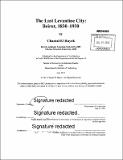The last Levantine City : Beirut, 1830-1930
Author(s)
El Hayek, Chantal
DownloadFull printable version (9.982Mb)
Alternative title
Beirut, 1830-1930
Other Contributors
Massachusetts Institute of Technology. Department of Architecture.
Advisor
Nasser Rabbat.
Terms of use
Metadata
Show full item recordAbstract
My thesis examines the urban transformation of Beirut between 1830 and 1930. Evolving from a local market city importing European goods and exporting local produce into a transit city for the re-export of European commodities, Beirut developed from a quadrilateral of thick crusader walls enclosing a labyrinth of narrow streets into a modem commercial center highlighted by the French-designed Place de l'Étoile. The new center connected the city with the port and with its hinterland through two major thoroughfares lined up with modem office buildings that, for the first time, accommodated underground storage spaces. My core questions are: What made Beirut develop in this direction? Why were the markets centered the way they were? I argue that the urban transformation of Beirut in the nineteenth century through World War I was a manifestation of a French imperial policy that had been at play a century before the French Mandate. Seeking to extend infrastructural networks, France saw Beirut, particularly through its port, as an economic base that would facilitate trade with the region. 'Beirut al- Jadida' (New Beirut) was ultimately created to provide a gateway for France to regain access into the region after an era of decline in French economic dominance in the Levant, in the wake of the Napoleonic Expedition into Egypt and Syria (1798-1801) and the abrogation of the Achelles du Levant system of trade by Ahmad Pasha Al-Jazzar (r. 1775-1804). In the second half of the nineteenth century, with the expansion of the port (1887-1890) and the construction of the carriageway (1857-1863) and railroad (1895) between Beirut and Damascus, French dominance rose once again-this time in a new political (colonial) form. The French agent intervening in the development of Beirut evolved from it being a financial investor-through private companies sponsoring the silk industry and other trades-in the early nineteenth century, to a major concession holder of various public works in the mid- to late-nineteenth century after the silk trade with the Levant had declined, to a military colonizer in the early twentieth century, when French economic dominance became a governmental pursuit no longer restricted to the operations of private businesses. My thesis seeks to explore how the change over time in economic and political activities, and in the interests of the colonizers in both the pre-colonial and colonial periods, was reflected in urban design and planning of the city. In my work, I propose a framework of analysis that sees the nineteenth- and early-twentieth- century development of Beirut as a continuous process of modernization and engagement with the international economic system in which both the Ottomans and French were invested, contrary to a significant number of scholarly works that tended to partition the city's history into two separate historical narratives tied to the two governing regimes.
Description
Thesis: S.M., Massachusetts Institute of Technology, Department of Architecture, 2015. Cataloged from PDF version of thesis. Includes bibliographical references (pages 74-83).
Date issued
2015Department
Massachusetts Institute of Technology. Department of ArchitecturePublisher
Massachusetts Institute of Technology
Keywords
Architecture.